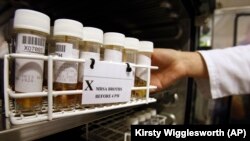The quest for new antibiotics got a boost with the recent discovery of lugdunin, a compound found in the nose that fights Staphyloccocus aureus, a human bacterium responsible for the superbug MRSA.
The CDC says there are 80,000 cases of MRSA — or Methicillin-resistant Staphyloccocus aureus — every year in the United States, and more than 10,000 deaths annually from the superbug, which has become resistant to many antibiotics.
Commonly known as staph, many people carry the bacterium harmlessly — in addition to billions of other microorganisms — in their bodies. But it is an opportunistic pathogen, and if it gets into the bloodstream, S. aureus can quickly overrun the body with a potentially lethal infection.
A common site for staph is in the nose, but researchers, reporting in the journal Nature Microbiology, discovered that 70 percent of the population does not carry S. aureus, according to Kim Lewis, director of the Antimicrobial Discovery Center at Northeastern University in Massachusetts.
"So if you have lugdunin in your nose, chances are you are not going to be carrying staph aureus. So that was the initial finding of that study," Lewis said.
Lugdunin is produced by another staphlyoccocus species.
It's survival of the fittest on a bacterial scale. Bacteria in our bodies compete for survival, just like animals in the wild. And Staphyloccocus lugdunensis makes a really odd-looking chain of amino acids scientists have dubbed lugdunin, that keeps S. aureus at bay.
But it gets even more interesting. When the scientists were poking around in people's noses, they found that roughly one-third of the population has S. aureus in their nose, but hardly anyone with the S. lugdunensis bacteria had any sign of the potentially harmful staph bacteria. But a few people had neither bacteria in their noses.
That raises the possibility that there are other bacteria in the body that can take out staph, and that could mean that there are some other antibiotic agents that have yet to be discovered.
Regaining upper hand
Lewis, who wrote a commentary in Nature Microbiology on the discovery of lugdunin, says there's a simple reason why researchers are looking high and low for new antibacterial agents.
"We want to stay alive. That's the short answer to that question,” Lewis said. “Pathogens have been acquiring resistance and that has been spreading. And now pathogens are gaining the upper hand. So we need to get back in the game and figure out new ways to discover antibiotics."
Lewis says antibiotics, many of which are still in use today, were discovered during the early to middle of the last century, a period known as the Golden Age of Antibiotics.
They were derived from compounds found in soil, a rich source of microorganisms. So that's where Lewis' Antimicrobial Discovery Center comes in.
"Only one percent of soil microorganisms are cultivable,” she said. “So the rest, the 99 [percent], are called the microbial Dark Matter. So, we are going after the microbial Dark Matter."
Lewis helped create a new platform, or method, to look for microorganisms that can be cultivated into antibiotics.
Last year, Lewis and his colleagues discovered teixobactin, an antibiotic that kills a number of bacteria, including Staphyloccocus aureus, by destroying their cell walls.
More traditional antibiotics attack bacterial proteins, and over time, the microbes develop mutations that make traditional antibiotics less effective. However, by attacking the cell wall, the researchers found there was no antibiotic resistance in animal models.
This new research means the human body itself might be the source of the new drugs to keep us healthy.










